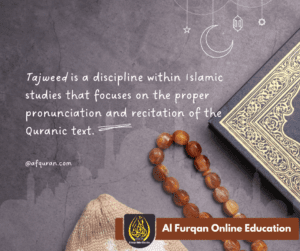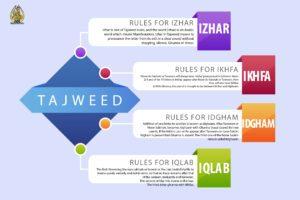
Introduction to Tajweed
Tajweed, an intricate and profound discipline within the realm of Islamic studies is the art and science of correctly reciting the Holy Quran. Derived from the Arabic root “J-W-D,” denoting improvement or enhancement, Tajweed is far more than a set of rules; it is a journey that leads to a deep connection with the divine words of the Quran. In this introduction, we embark on an exploration of Tajweed, delving into its significance, historical roots, and pivotal role in preserving the purity and eloquence of the Quranic text.
Origin and Meaning of Tajweed
Meaning
This word derived from the Arabic root “J-W-D,” signifies improvement and enhancement in the context of Quranic recitation.

- Etymological Roots:
Tajweed encapsulates the essence of refining the pronunciation and articulation of the Quranic verses. - J-W-D Connotations:
Rooted in the linguistic richness of “J-W-D,” Tajweed emphasizes the beautification and perfection of Quranic delivery. - Continuous Improvement:
Tajweed, as a verb, represents an ongoing journey of refinement, urging practitioners to elevate their recitation continuously. - Rules and Principles:
Tajweed involves a set of rules and principles ensuring Arabic letters’ accurate pronunciation and characteristics. - Artistic Dimension:
Tajweed introduces an artistic dimension to Quranic recitation beyond technicalities, enhancing its beauty and aesthetic value. - Holistic Approach:
Tajweed goes beyond audible elements, synchronizing sound with meaning to create a harmonious connection between reciter and text. - Integration of Sound and Meaning:
Tajweed acts as a linguistic bridge, fostering seamless integration of accurate pronunciation with the profound meanings of the Quranic verses. - Dynamic Endeavor:
Tajweed is not static; it is a dynamic, ongoing process that encourages a continuous quest for improvement in recitation. - Spiritually Resonant Experience:
Ultimately, Tajweed transforms the act of reciting the Quran into a spiritually resonant experience, elevating it beyond mere pronunciation to a sublime and meaningful engagement with the divine text.
Purpose of Tajweed

Enhancing Quranic Recitation:
The primary purpose of Tajwid rules is to enhance the beauty and precision of Quranic recitation.
- Preserving Authenticity:
Pronounciation rules play a vital role in preserving the authenticity of the Quran by ensuring accurate pronunciation and articulation. - Conveying Intended Meanings:
Reciters ensure that the intended meanings of Quranic verses are accurately conveyed by adhering to rules. - Respecting Divine Revelation:
Following the rules of the Quran shows respect for the divine revelation, emphasizing the importance of delivering the Quran with utmost precision. - Preventing Distortion:
Following the rules of the Quran act as a safeguard against unintentional distortions in pronunciation, maintaining the integrity of the sacred text. - Spiritual Connection:
Following Tajweed rules fosters a deeper spiritual connection between the reciter and the divine message, creating a more profound recitation experience. - Reflecting Prophetic Tradition:
These rules aligns with the tradition of Prophet Muhammad (peace be upon him), ensuring that reciters emulate his exemplary Quranic delivery. - Eloquence and Rhythm:
This discipline contribute to the eloquence and rhythmic flow of Quranic verses, enhancing the auditory experience for both reciters and listeners. - Educational Foundation:
Tajweed serves as an educational foundation, providing a structured set of rules that guide learners in mastering the art of Quranic recitation. - Cultural and Linguistic Heritage:
Clearness of Quran Recitation also contribute to preserving the cultural and linguistic heritage embedded in the Quran, emphasizing the importance of passing down this heritage with precision and care.
Historical Significance of Tajwid
-
Rooted in Islamic Scholarship:
The historicalsignificance of advanced Tajweed lies in its deep roots within Islamic scholarship, where scholars recognized its pivotal role in preserving the Quranic text.
- Centuries of Preservation:
Over centuries, advanced Tajweed has been instrumental in meticulously preserving the Quran, ensuring that the original pronunciation and meanings remain intact. - Scholarly Contributions:
Islamic scholars throughout history have made significant contributions to developing and refining advanced Tajweed rules, passing down their knowledge through generations. - Refinement of Pronunciation:
The historical narrative underscores how advanced Tajweed rules emerged as a response to the need for refining the pronunciation of the Quran with a higher level of proficiency. - Nuanced Pronunciation Techniques:
Advanced Tajweed delves into nuanced techniques such as ghunnah (nasalization), idgham (assimilation), and iqlab (transformation), reflecting a sophisticated approach to Quranic recitation. - Connection to Prophetic Tradition:
The advanced Tajweed rules are intricately connected to the prophetic tradition, aligning with the exemplary recitation of Prophet Muhammad (peace be upon him). - Cultural Heritage:
Beyond rules, advanced Tajweed embodies a cultural heritage, representing a continuum of linguistic precision and aesthetic excellence passed down through generations. - Preservation Amid Diverse Pronunciations:
Throughout history, advanced Tajweed has maintained consistency and accuracy in Quranic recitation, especially in diverse linguistic contexts. - Educational Legacy:
The historical legacy of advanced Tajweed is educational, where the mastery of these rules symbolizes a commitment to the highest standards of Quranic knowledge. - Continued Reverence:
The historical significance of advanced Tajweed persists as contemporary learners approach the Quran with reverence, studying and applying these rules to maintain the sanctity of the Holy Book.
Quranic Authority for Enhance Pronouciation

-
Quranic Emphasis on Beautiful Recitation
- The Quran itself profoundly emphasizes the beauty and clarity of recitation. This section explores the verses that highlight the significance of mastering Tajwe-ed as a means to fulfill the Quranic directive of reciting the verses beautifully.
-
Encouragement to Learn Tajwe-ed Directly from the Quran
Delving into specific verses that encourage believers to learn Tajwid directly from the Quran, emphasizing the importance of deriving Tajweed rules from the divine text.
-
The Prophetic Model: Learning Tajwed from the Sunnah
- Exploring the traditions of Prophet Muhammad (peace be upon him) and how they serve as a source of guidance for learning Tajwiid, reinforcing the importance of aligning one’s recitation with the prophetic model.
-
Quranic Authority as a Motivator to Learn Tajweed
</li>
- Examining how the authority of the Quran serves as a motivator for individuals to learn Tajweed diligently, recognizing the Quran as the ultimate source of guidance in perfecting the art of recitation.
-
Wisdom Behind Tajweed Rules: Quranic Insights
- Analyzing Quranic insights that shed light on the wisdom behind Tajweed rules, demonstrating how each rule is rooted in the divine text and contributes to preserving the eloquence and meaning of the Quranic verses.
-
Mastery of Tajweed as a Spiritual Connection with the Quran:
- Highlighting verses that underscore the spiritual dimension of learning Tajweed, emphasizing that mastery of Tajweed is not just a technical skill but a means to establish a profound connection with the Quran.
-
Recognition of Tajweed Competence in the Quranic Context:
- Exploring verses that recognize and commend the competence of individuals in Tajweed, showcasing how learning Tajweed is a pathway to receiving acknowledgment and reward from the divine.
-
Quranic Verses on the Consequences of Neglecting Tajweed:</strong>
</li>
- Examining verses that discuss the consequences of neglecting Tajweed, underscoring the Quranic perspective on the importance of preserving the accurate pronunciation and meanings of its verses.
-
Tajweed as a Means of Understanding Quranic Nuances
- Delving into verses that implicitly convey the nuanced meanings within the Quran, illustrating how learning Tajweed facilitates a deeper understanding of the subtleties embedded in the divine text.
-
Quranic Encouragement for Continuous Learning
- Concluding with verses that encourage a continuous pursuit of knowledge, emphasizing that the process of learning Tajweed is an ongoing journey guided by the Quran, promoting as a lifelong commitment to the art of beautiful Quranic recitation…
Basic Components of Tajweed

-
Fundamentals of Tajweed: A Prerequisite for Advanced Mastery
- This section introduces the foundational components of Tajweed, emphasizing their significance as the building blocks for anyone aiming to learn the rules of advanced Tajweed of the Holy Quran.
-
Makharij: Understanding Points of Articulation
- Exploring the concept of Makharij, which refers to the precise points of articulation for each Arabic letter. This foundational knowledge is crucial for anyone looking to advance their Tajweed skills.
-
<st
rong>Sifaat: Grasping the Attributes of Letters
- Diving into Sifaat, the unique attributes of Arabic letters that influence their pronunciation. Understanding these attributes is essential for learners aiming to advance their mastery of Tajweed.
-
<strong>Rules of Elongation (Madd): Establishing Rhythmic Fluency
- Delving into the rules of elongation (Madd) as a fundamental aspect of Tajweed contributes to the rhythmic fluency of Quranic recitation. Mastery of these rules is crucial for those aspiring to learn the advanced Tajweed of the Holy Quran.
-
Shortening Sounds: Precision in Articulation
- Exploring the rules of shortening sounds in Tajweed contributes to precision in articulation. This foundational knowledge lays the groundwork for learners aspiring to delve into advanced Tajweed.
-
<strong>Transitioning to Advanced Tajweed: Ghunnah</strong>
</li>
- Introducing advanced concepts such as Ghunnah, the nasalization of specific sounds. Understanding Ghunnah is a critical step for learners transitioning from basic to advanced Tajweed.
-
<strong>Assimilation (Idgham) and Transformation (Iqlab): Nuances in Pronunciation
- Examining advanced rules like Idgham (assimilation) and Iqlab (transformation) involve nuanced pronunciation changes. These components add complexity to Tajweed, requiring
- <li>a deeper level of understanding.
-
Harmonizing Pronunciation and Meaning: Advanced Tajweed Insights</strong>
</li>
- Highlighting how advanced Tajweed goes beyond basic rules, focusing on the harmonious integration of pronunciation with the profound meanings encapsulated in the Quranic verses.
-
Advanced Techniques for Eloquence: Beyond Basic Articulation
- Exploring advanced techniques in Tajwid-ul-Quran that contribute to eloquence in recitation. This section emphasizes the transition from basic articulation to a more refined and aesthetically pleasing recitation.
-
Continuous Learning: The Journey to Mastering Advanced Tajweed
</li>
- C
- oncluding with the idea that learning the rules of advanced Tajwid-ul-Quran is a continuous journey. Emphasizing the importance of ongoing commitment and practice for those dedicated to mastering the art of reciting the Holy Quran with precision an beauty.
Rules of Elongation (Madd) in Tajweed

-
-
-
Introduction to Rules of Elongation (Madd) in Tajweed
- This section provides an overview of the significance of rules of elongation (Madd) in Tajwid-ul-Quran and their role in enhancing the rhythmic flow and beauty of Quranic recitation.
-
Understanding the Purpose of Elongation
- Exploring the fundamental the purpose behind the rules of elongation (Madd) in Tajwid-ul-Quran , which involves extending the duration of specific Arabic letters to create a harmonious and melodious recitation.
-
Types of Madd: A Foundation for Advanced Tajweed
- Introducing the various types of elongation (Madd) in Tajwid-ul-Quran such as “Madd Asli” (original elongation) and “Madd Far’i” (secondary elongation). This distinction sets the foundation for learners aiming to advance their Tajweed skills.
-
Recognizing the Letters of Madd
- Identifying the specific letters that can undergo elongation (Madd), understanding their characteristics, and learning how to apply these rules accurately in Quranic recitation.
-
Rules for Elongating Vowels (Madd Munfasil)
- Delving into the regulations for elongating vowels (Madd Munfasil), where certain vowels are lengthened within a word. Mastery of these rules is crucial for learners seeking to advance their Tajwid-ul-Quran proficiency.
-
<strong>Elongation Due to Hamzah (Madd Al-Mutasil)
- Exploring the rules of elongation due to Hamzah (Madd Al-Mutasil), where the elongation is caused by the presence of Hamzah at the end of a word. This component adds a layer of complexity to Tarteelrules.
-
Guidelines for Silent Alif (Madd Al-Leen)
- Understanding the rules of elongation related to the silent Alif (Madd Al-Leen), where an elongation occurs due to the presence of a hidden Alif within a word. This nuanced aspect requires attention for a comprehensive grasp of advanced Tarteel.
-
Advanced Techniques: Connecting Elongation Rules
- Exploring advanced techniques in connecting various rules of elongation (Madd), emphasizing the importance of fluidity and coherence in applying these rules during Quranic recitation.
- Harmonizing Elongation with Meaning: An Advanced Tajweed Perspective
- lighting the significance of harmonizing elongation (Madd) with the meanings of the Quranic verses, show easing how an advanced understanding ofTajweed involves a holistic approach to recitation.
-
Practical Application and Continuous Learning
- Concluding with the importance of practical application, encouraging learners to implement the rules of elongation (Madd) in their recitation. Emphasizing that mastering these rules is an ongoing journey in pursuing advanced Tajwied proficiency in reciting the Holy Quran.
-
-
Shortening Sounds in Tajweed
Understanding the rules and significance of shortening sounds in Tajweid, ensuring a balanced and harmonious recitation.
-
-
-
Introduction to Shortening Sounds in Tajweed
- This section introduces the concept of shortening sounds in Tarteel , emphasizing its importance in creating precision and clarity in Quranic recitation. It serves as a foundational element for those aspiring to learn the advanced rules of Tarteel in the Holy Quran.
-
Purpose and Significance of Sound Shortening
- Exploring the fundamental the purpose behind shortening sounds in Tajweed, highlight its role in maintaining a balanced and measured pace in recitation, contributing to the the overall aesthetic quality of Quranic recitation.
-
Recognizing Sounds Eligible for Shortening
- Identifying the specific sounds and letters that are eligible for shortening in Tajweed, understanding the characteristics of these letters, and laying the groundwork for advanced learning in Tarteel.
-
Rules for Shortening Consonants (Qalqala)
- Delving into the laws of Qalqala is a specific type of sound shortening involving a slight bounce or vibration in pronouncing certain consonants. This adds a nuanced layer to Tarteel rules and prepares learners for more advanced applications.
-
Shortening Due to Sukoon (Jazm)
- Exploring the rules of shortening sounds due to Sukoon (Jazm), where a consonant is pronounced with a complete cessation of airflow. This aspect of Tarteel requires meticulous attention to detail.
-
-
-
- Advanced Techniques: Coordinating Sound Shortening Rules
- Examining advanced techniques for coordinating different rules of sound shortening, emphasizing fluency and coherence in applying these rules during Quranic recitation.
-
<strong>Harmonizing Sound Shortening with Meaning: Advanced Tajweed Insights
- Highlighting the importance of harmonizing sound shortening with the meanings of the Quranic verses, showcasing how an advanced understanding of Tarteel involves a holistic approach to recitation.
- Considerations for Pauses and Stops (Waqf)
- Discussing the considerations for pauses and stops (Waqf) in the context of sound shortening, exploring how these elements contribute to the overall rhythm and cadence of Quranic recitation.
-
Practical Application: Integrating Sound Shortening Rules
- Encouraging practical application of sound shortening rules in Quranic recitation, providing examples and exercises to reinforce learning and prepare individuals for advanced Tarteel mastery.
-
Continuous Learning and Mastery
- Concluding with the idea that mastering the rules of sound shortening in Tarteel is a continuous journey. Emphasizing the importance of ongoing commitment and practice for those dedicated to advancing their proficiency in the art of reciting the Holy Quran with precision and beauty.
Advanced Concepts in Tajweed</h3>
ides an overview of the advanced concepts in Tajweed, emphasizing their significance in elevating Quranic recitation to a higher level of proficiency and beauty.

-
-
-
Ghunnah: Nasalization in Advanced Tajwid-ul-Quran
- Exploring the advanced concept of Ghunnah, which involves nasalization of specific sounds during Quranic recitation. Understanding Ghunnah is crucial for learners aiming to advance their Tarteel skills.
-
Idgham: </h4>
- Delving into the advanced concept of Idgham, where certain letters are assimilated into others, requiringa nuanced understanding of pronunciation. Mastery of Idgham is an essential component of advanced Tarteel.
-
Iqlab: </strong>
- Exploring Iqlab, an advanced The Tarteel concept involves transforming one letter into another under specific conditions. This section provides insights into the intricacies of this transformation.
-
Characteristics of Advanced Pronunciation
- Examining the nuanced elements of advanced pronunciation in Tarteel, emphasizing the importance of precision and accuracy in articulation for an advanced level of Quranic recitation.
-
Advanced Techniques for Articulation
- Introducing advanced techniques that contribute to eloquence and precision in articulation, providing learners with a deeper understanding of the subtleties involved in advanced Tarteel
-
Integrating Advanced Concepts with Basic Rules
- Exploring how advanced concepts seamlessly integrate with basic Tajweed rules, emphasizing the interconnectedness of these elements for a comprehensive understanding of advanced Tajweed.
-
Connection to Prophetic Tradition</strong></h4>
- Highlighting the connection between advanced Tajweed concepts and the traditions of Prophet Muhammad (peace be upon him), underscoring the importance of aligning recitation with the exemplary model set by the Prophet.
-
Harmonizing Advanced Concepts with Quranic Meaning
- Emphasizing the significance of harmonizing advanced Tarteel
-
-
- concepts with the meanings of the Quranic verses, showcasing how an advanced understanding involves a holistic approach to recitation.
-
Practical Application and Continuous Learning
- Concluding with the importance of practical application, encouraging learners to implement advanced Tajweed concepts in their recitation. Emphasizing that mastering these concepts is an ongoing journey in pursuing advanced Tajweed proficiency in reciting the Holy Quran.
The Role of Tajbid in Preserving the Quranic Text
Highlighting how Tajweed acts as a safeguard, preventing any unintentional alteration of the Quranic text during recitation.
-
-
-
-
The Preservation Imperative: Introduction </h4></h4>
- This section introduces the critical role of Tajweed in preserving the Quranic text, emphasizing its significance as a safeguard against unintentional alterations in recitation.
-
Maintaining Purity: as a Guardian of Authenticity
- Exploring how Tajwied acts as a guardian, ensuring the purity and authenticity of the Quranic text by preserving each letter’s original pronunciation and characteristics.
-
The Historical Legacy in Islamic Scholarship</strong></strong>
- Examining the historical legacy of Tajweed within Islamic scholarship, emphasizing how scholars recognized its role in maintaining the integrity of the Quranic text.
- Quranic Emphasis on Precision: Tajweed-ul-Quran Rules in Divine Revelation verses in the Quran that encourage precise and beautiful recitation, establishing the foundation for Tajwied rules as a divine
- Preventing Distortions: Tajweed as a Safeguard Mechanism
-
-
-
- Delving into how Tajwid-ul-Quran rules act as a safeguard mechanism, preventing unintentional distortions during recitation and ensuring the accurate transmission of the Quranic message.
-
Consistency Across Generations: Tajweed in Transmission
- Exploring how Tajwid-ul-Quran contributes to the consistency of Quranic recitation across generations, maintaining a standardized approach to pronunciation and articulation.</li>
-
Harmony of Sound and Meaning: Tajweed as a Linguistic Bridge
- Examining how Tajwyd serves as a linguistic bridge, harmonizing sound with meaning and enhancing the overall comprehension of the Quranic verses.</li>
-
Respect for the Divine Word: Tajweed as an Act of Reverence</strong>
- Discussing how adherence to Tajwid-ul-Quran rules is an act of reverence, showcasing respect for the divine word and a commitment to conveying its meanings accurately.
-
The Art of Memorization: Tajweed’s Influence on Hifz
- Exploring Tarteel’s role in the memorization (Hifz) of the Quran, emphasizing how proper pronunciation aids in memorizers’ accurate retention of verses.</li>
-
Online Resources for Learning Tajweed: Accessible Preservation
- Concluding with the availability of online resources, such as platforms for learning advanced Tajweed, that contribute to the ongoing preservation of the Quranic text. Emphasizing the importance of utilizing these resources for a comprehensive understanding of Tajweed rules.
Online Learning Platforms for Tajbid
The emergence of onlineresources, like afquran.com, providing accessible and structured courses forlearners of all levels.
-
The Rise of Online Learning Platforms for Tajbid
- This section introduces the evolution of online learning platforms for Tajwid-ul-Quran
, highlighting the convenience and accessibility they offer to individuals seeking to learn the advanced rules of Tajweed for the Holy Quran. -
Advantages of Online Learning: Flexibility and Convenience
- Exploring the benefits of online learning, emphasizing the flexibility and convenience it provides for learners to engage with Tajweed lessons at their own pace and according to their schedules.</li>
-
Tailored Learning Experience: Personalized Instruction for Advanced Tajbid
- Highlighting the advantage of personalized instruction on online platforms, showcasing how learners can receive tailored guidance and feedback to advance their Tajwid-ul-Quran skills effectively.
-
Structured Curriculum: Comprehensive Learning of Advanced Tajwid-ul-Quran
- Discussing the importance of a structured curriculum on online platforms, ensuring that learners progress systematically through advanced Tajweed concepts for a thorough understanding.
-
Al Furqan Online Education: A Distinctive Learning Hub
- Introducing Al Furqan Online Education as a distinctive learning hub for mastering Tajweed, emphasizing its commitment to providing high-quality education in advanced Tajweed rules.
-
Expert Instructors: Guiding Towards Tajbid Mastery
- Highlighting the expertise of instructors at Al Furqan Online Education, showcasing their qualifications and experience in guiding learners toward mastering the intricate rules of advanced Tajweed.
-
Cutting-Edge Teaching Methods: Innovative Approaches to Tajbid
- Exploring the use of advanced teaching methods on the platform, such as interactive lessons, multimedia resources, and engaging activities to enhance the learning experience.
-
Community Support: Connect with Tajbid Learners Worldwide
- Emphasizing the sense of community on the online platform, where learners can connect with peers worldwide, share experiences, and collaborate in their journey to master advanced Tajweed.
-
Recognition and Certification: Validating Tajbid Proficiency
- Discussing the value of recognition and certification provided by Al Furqan Online Education, showcasing how learners can validate their proficiency in advanced Tajweed.
-
Join Al Furqan Online: Taking the Next Step in Tajbid Mastery
- Concluding with a call to action, inviting individuals to join Al Furqan Online Education for a masterful journey in learning advanced Tajweed. Encouraging interested learners to visit the website <a href=”https://afquran.com/”>afquran.com and submit their student form at Become a Student.
-
Advantages of Online Quran Learning
- Exploring the benefits of online learning, including flexibility, personalized instruction, and thethe convenience of self-paced study.
13.Tajweed Courses for Beginners</h3>
Tailored courses catering to those new to Tajweed, employing simplified techniques and resources for effective learning.
Color-Coded Tajbid Quran
An innovative visual aid, assigning different colors to specific Tajwid-ul-Quran rules to facilitate easier recognition and application.
Integration of Tajbid with Arabic Alphabet
Understanding the intrinsic the connection between Tajweid rules and the Arabic alphabet, emphasizing the harmony in their application.
Tajbid for Children
Strategies and resources for introducing children, emphasizing the importance of cultivating a love for Quranic recitation from a young age.</p>
Simplified Tajbid Techniques
Breaking down complex Tarteel rules into manageable concepts, making the learning process more accessible for beginners.
Challenges in Tajbid Learning
Addressing common hurdles faced by learners, such as grasping intricate rules or finding consistent practice time.
Recognizing Achievements in Tajweid-ul-Quran
The importance of acknowledging and celebrating milestones and successes throughout the journey of mastering Tajwid-ul-Quran.
Conclusion: Tajweed as a Spiritual and Artistic Journey
Summarizing Tajweed not only as a set of rules but as a transformative journey that deepens the connection with the divine through the beauty of Quranic recitation.







